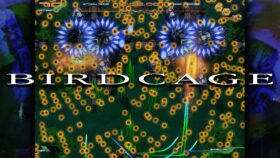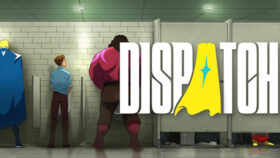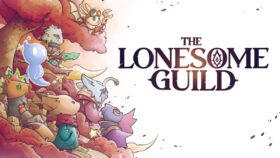Saltsea Chronicles is the kind of game that’s ideal to be carried around with you, like a book. On a handheld console, you can casually read through a chapter while you’re at the park or on the train – which would actually be quite fitting, given the game’s themes of environmentalism and the developer’s consciousness of climate impact. But in other circumstances, it can feel like a slow burn.
A narrative adventure from Die Gute Fabrik (Mutazione), Saltsea Chronicles has you traversing the post-apocalyptic, flooded world of Saltsea with the motley crew of a battered old ship, the De Kelpie. The crew are newly formed and yet to fully trust each other, when their captain, Maja, goes missing and they’re forced to mount a rescue mission. What ensues is a meandering pursuit through the sprawling islands of Saltsea, guided by your decisions. “There are no wrong choices, only your choices,” the game emphasises.
It’s a slow start, beginning with a prologue where the crew contentedly tell stories around the campfire, before Maja disappears in the dead of night. Then, the remaining members – Molpe, Stew, Murl and Iris – spend an extended period of time looking for clues and talking to islanders on their home base island of Njarfie Roust.
This opening feels like it overstays its welcome – perhaps mirroring the feelings of the crew, who feel unwanted by the residents of Njarfie Roust. But this atmosphere also foreshadows the issues I eventually had with the game’s narrative overall. It feels like the characters are too slow or unwilling to pick up on the obvious truth: there’s no trace of Maja.
Eventually, you commandeer the De Kelpie and begin your journey across the strange yet somehow familiar lands of Saltsea, in an attempt to find some answers. Was Maja kidnapped or did she choose to leave? Why was a silent ship with indigo sails sighted near the island? It takes a thorough investigation, leading the crew to all four corners of the world, to get to the bottom of this.

Each part of your voyage will vary greatly based on your choices. Across the twelve chapters, framed as episodes, you consistently encounter forked paths; in choosing which island to visit next, which two crew members to disembark with, and what tone your conversations with island inhabitants will take.
It’s a refreshing investigative system, leading your playthrough in distinct directions with each ‘this or that’ decision. But despite there being no right or wrong answer, I still felt some pressure to choose “correctly”, because of the knowledge that I was cutting out a massive set of narrative possibilities with every choice. The game itself lets you branch your save file from any completed chapter, so you can see where the other roads lead if you’re willing to replay – though I found a single playthrough to be exhausting enough as it was.
The act of investigating Maja’s disappearance becomes tiresome because the pacing is so slow. You’ll typically find yourself doubling back to a person or place over and over again before you’ve uncovered all the information, which feels repetitive. Investigating with two crew members, and then debriefing the others in a round table discussion upon returning to the De Kelpie, went from feeling like a clever way to punctuate the story to a chore or obligation, because I was having things spelled out for me that were obvious the first time around.
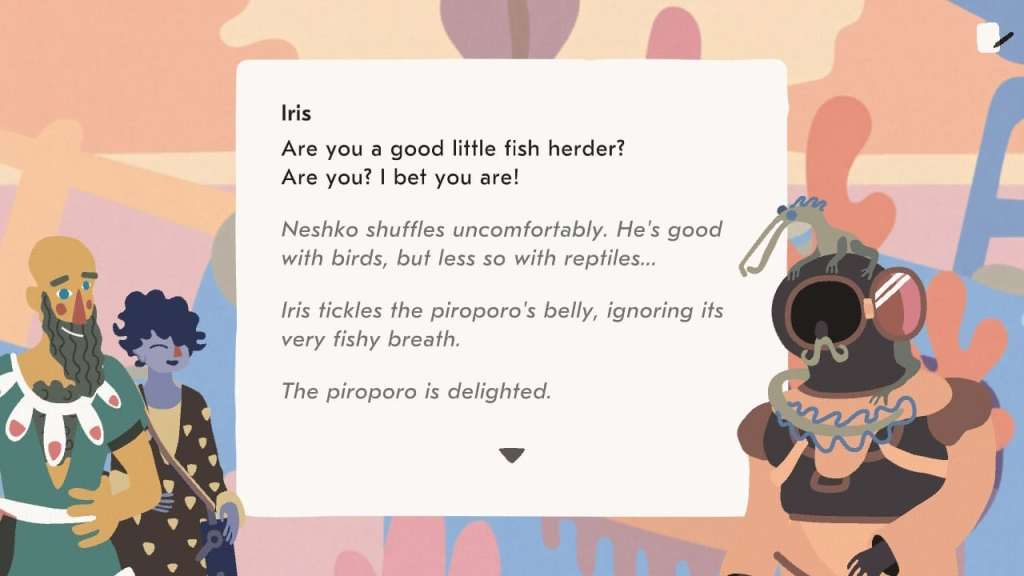
My gripes with the pacing were also largely influenced by the fact that I wasn’t enjoying the company of the De Kelpie’s crew. Whether baked into their character or affected by my choices, many of them behaved in irritating or bratty ways during my playthrough. When the stakes run high, so do emotions – and their relationships were messy in the most characteristically human ways.
I appreciated their authenticity, their vibrant personalities, and how they each represented subversive takes on archetypal characters, such as The Caregiver (Molpe) or The Explorer (Stew). But ultimately, I didn’t enjoy putting in the effort to catch myself up on their pre-existing relationships, or keeping on top of everything that had happened when I wasn’t directly watching them interact. It felt more like work than play.
I was constantly caught between feeling like I couldn’t skip a single piece of dialogue (as that could result in missing important events that would eventually lead to the resolution of a conflict or alteration of a relationship), and wanting to rush through because every little detail was drawn out so much.
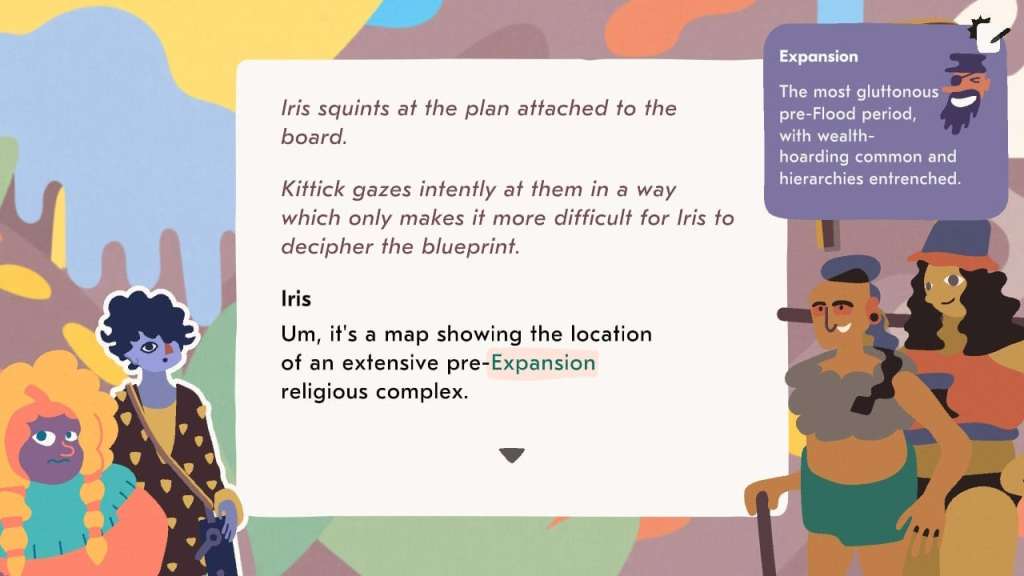
Given that Saltsea Chronicles is told through a large volume of text, with the offbeat visuals and music serving as an aid, rather than a necessity to the storytelling, it would ideally hold a fine balance between action, dialogue and narrative exposition. It doesn’t always manage to do so. The writing feels dense and difficult to push through; both because of the amount of detail included and the language used to present it.
I’m not the type of person to skim over sentences in a book, because I have to pay close attention to a story to absorb what’s going on. It’s not in my nature to skip dialogue in a narrative game for the same reason, but Saltsea Chronicles pushed me to do so in a few instances, simply because I wanted to move on.
Furthermore, I sometimes struggle with reading comprehension, and on more than one occasion a sentence caused my brain to short-circuit, requiring me to re-read it. It’s encouraging to see that the developers are conscious of accessibility, having included a number of settings such as a dyslexic font and the option to turn off text animations, but these didn’t help me when it came to disjointed sentence structures, unnecessarily complex word choices or the myriad of game-specific vocabulary.
It’s worth flagging this for players with cognitive disabilities, those who are dyslexic, neurodivergent, non-native English speakers, and those with any other factors that impact reading, because it may affect their experience.
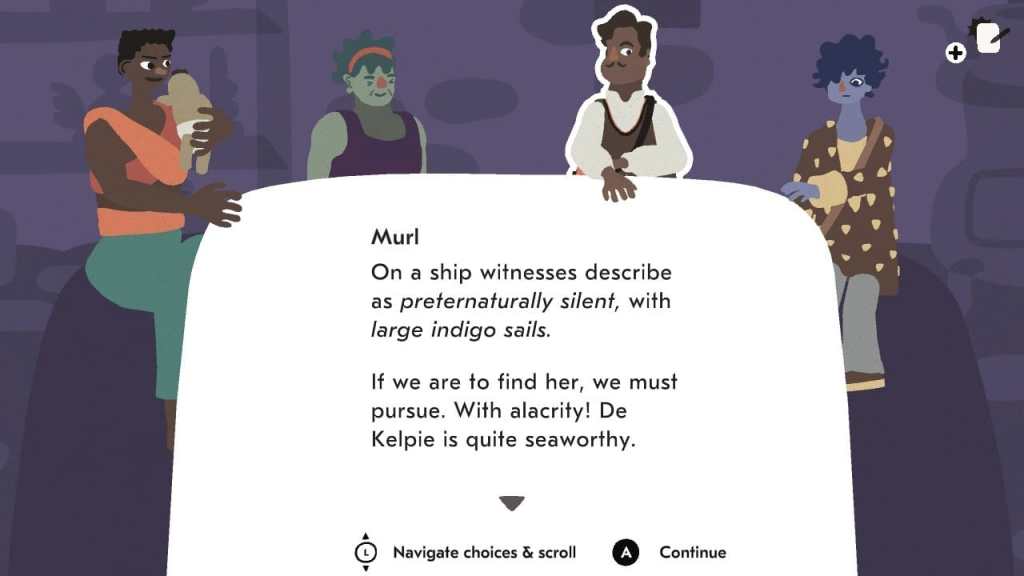
Writers should be free to be expressive and imaginative in their work – and some people will argue that not all games even need to be accessible – but I came away feeling that the particularly wordy passages of text hindered the overall storytelling in Saltsea Chronicles, regardless of context.
My experience with Saltsea Chronicles was a very conflicted one. It’s unlike anything I’ve played before and I appreciated its genuine uniqueness. It boasts an intricately crafted world with an intriguing investigative system, colourful characters and seemingly endless choices. But as much as I liked the narrative conceit, the way it unfolded felt long-winded in a way that struggled to keep a firm hold of my attention.
Three Stars: ★★★
Saltsea Chronicles
Platforms: PC, PlayStation 5,
Developer: Die Gute Fabrik
Publisher: Die Gute Fabrik
Release Date: 12 October 2023
The



